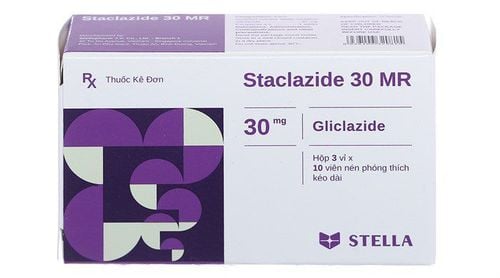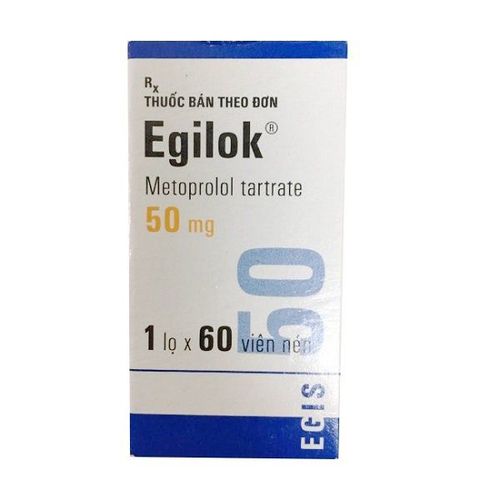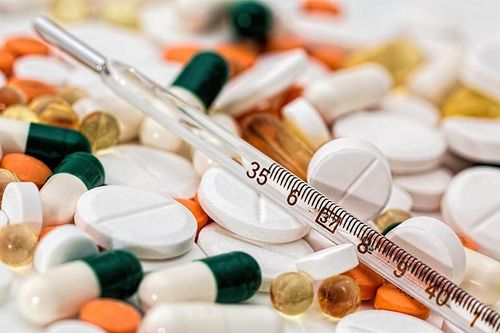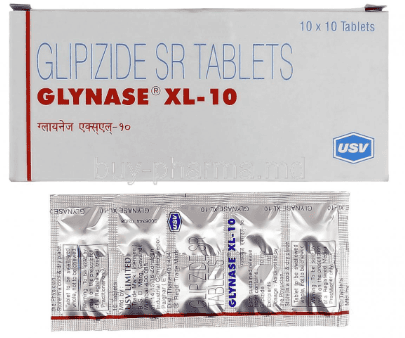This is an automatically translated article.
Scilin M30 40IU contains the active ingredient insulin, which is indicated in the treatment of insulin-dependent diabetes mellitus (type 1). Let's learn about the uses and notes when using Scilin M30 40IU through the article below.
1. Uses of Scilin m30 40iu
1.1. Indications Scilin M30 containing active ingredient insulin is indicated in the following cases:
Patients with type 1 diabetes (insulin dependent diabetes); Patients with type 2 diabetes (non-insulin dependent diabetes mellitus) when treatment with synthetic antidiabetic agents is ineffective, diabetic coma, acidosis, severe infection or when surgery is required. present major surgery; Hyperglycemia emergency in the following cases: Hyperglycemic coma, diabetic ketoacidosis, non-ketotic hyperosmolarity; Use in patients with intravenous infusion of nutritional supplements but poor glucose tolerance; Patients with progressive diabetic retinopathy; Gestational diabetes 1.2. Pharmacokinetics Insulin is secreted by the beta cells of the islets of Langerhans in the pancreas. The factor that regulates insulin secretion is blood glucose concentration. In normal people, the process of insulin secretion occurs irregularly, in which secretion is greatest at meals. The effect of insulin on stabilizing blood glucose levels occurs after insulin binds to specific receptors on the cell surface of insulin-sensitive tissues, especially skeletal muscle, adipose tissue, and liver.
Insulin acts by inhibiting the production of glucose in the liver, increasing the use of glucose in the periphery and thereby reducing the concentration of glucose in the blood. In addition, insulin also inhibits the breakdown of adipose tissue, preventing the formation of ketone bodies. The anabolic effect of insulin due to its influence on lipid, glucide and protein metabolism. The drug is broken down in muscle tissues, liver and kidneys.
Insulin is used in replacement therapy in patients with partial or complete deficiency of insulin in the body. Human insulin is prepared by recombinant DNA technology using a non-pathogenic laboratory strain of Escherichia coli.
1.3. Pharmacokinetics In normal subjects about 5% of insulin is bound to plasma proteins, CSF is found to be the site of insulin concentrations of about 25% of serum insulin concentrations. The drug is metabolized in the kidneys and liver, a small amount is metabolised in muscle and adipose tissue.
Metabolism of insulin in normal people and people with diabetes is the same. Most of the drug is eliminated by the kidneys, a small amount is excreted in the bile. The half-life (t1/2) of insulin is approximately 4 minutes. Renal and hepatic impairment may increase the half-life of the drug. In the elderly, the insulin elimination process is slower, the hypoglycemic effect lasts longer.
2. Dosage and how to use Scilin m30 40iu
2.1. How to use Scilin M30 40IU is administered by subcutaneous injection, with only a few exceptions it is administered intramuscularly. Inject the drug into the thighs, abdomen, outer biceps, buttocks. Inject the drug 30 minutes before meals. The steps are as follows:
Clean hands before injecting; Clean the injection site with medical alcohol; Clean the rubber stopper on the vial (be careful not to open the rubber cap); Shake the vial gently so that the solution in the vial becomes homogeneous; Using a sterile syringe inserted through the rubber stopper, aspirate the required amount of medicine; Perform subcutaneous injection according to the correct technique. 2.2. Dosage The dose of the drug depends on the patient's condition and is adjusted according to the results of regular monitoring of blood glucose levels. The patient should take the medicine exactly as prescribed by the doctor. The recommended dose of scilin M30 40IU is as follows:
Usual adult starting dose: Approximately 20-40 IU/day, increasing dose by about 2IU/day until desired blood glucose levels are achieved. The total daily dose should not exceed 80IU.
Ketosis, diabetic coma : Use insulin for emergency management of diabetic ketoacidosis. Note that only soluble short-acting insulin should be used. Adjust dose according to blood glucose concentration.
Children under 12 years of age: The recommended starting dose for children with early detection of moderate hyperglycemia and no presence of ketonuria is 0.3 to 0.5 IU/kg/day injection. subcutaneous.
Patients with kidney failure, liver failure, the elderly over 65 years old: Dosage and administration of the drug according to the instructions of the treating doctor, depending on the needs of the patient.
2.3. Overdose and treatment Symptoms of drug overdose: Feeling anxious, intense hunger, sweating, shaking hands and feet, difficulty concentrating, vomiting. In case the patient has mild hypoglycemia, just eat foods containing carbohydrates, drink soft drinks... Besides, the patient should be rested. Severe hypoglycemia can lead to loss of consciousness, seizures, or death.
Treatment: In case the patient is comatose, it is necessary to give glucose intravenously. Excessive use of insulin will lead to hypokalemia, thereby reducing muscle tone. In case of acute hypoglycaemia and the patient is unable to eat or drink, it is recommended to inject 1g of muscle glycogen or intravenous glucose.
3. Scilin m30 40iu side effects
Scilin M30 medicine can cause some unwanted effects as follows:
Hypoglycemia: This side effect usually appears suddenly with symptoms such as dizziness, sweating, feeling hungry, shaking hands legs, anxiety, tingling sensation in the limbs, tongue or lips, insomnia, concentration disturbances, sleep disturbances, dilated pupils, loss of control, speech disturbances, visual disturbances, irritability glass. Severe hypoglycemia can lead to temporary impairment of brain function, unconsciousness or death; Hyperglycemia: May lead to vomiting, nausea, flushing, drowsiness, dry mouth, thirst, increased urination, loss of appetite, ketone breath, dehydration, coma and death; Other: Insulin resistance, insulin allergy, post-injection lipodystrophy (adipose tissue hypertrophy or lipoatrophy).
4. Note when using Scilin m30 40iu
4.1. Contraindications Contraindicated to use scilin M30 40IU in the following cases:
People are suffering from hypoglycemia; Hypersensitivity to insulin or any of the ingredients of Scilin M30 40IU; Patients treated with insulin alone intermediate and long acting in the case of diabetic coma, acidosis. 4.2. Precautions for use Only the treating physician can change the dose and insulin combination. Patients need to inform the treating doctor if there are any early manifestations of allergy to insulin as well as other drugs, foods, drinks...
During insulin treatment, people Patients need to monitor blood sugar and urine, HbA1C levels, blood fructose levels. Besides, patients need to learn how to self-monitor blood sugar and urine with simple tests. Symptoms of drug-induced hypoglycemia vary from person to person. Therefore, patients need to learn to recognize the symptoms of hypoglycemia for themselves. In the event of hypoglycemia, even mild, it is necessary to notify the doctor to change the insulin dose or diet.
Use of drugs needs to be combined with an effective diet and exercise regimen. Insulin requirements are reduced in cases of increased physical activity, where insulin injections promote a more rapid hypoglycaemia.
Ability to drive and operate machines: Disorders in the ability to drive and operate machines may occur during early insulin therapy.
Pregnant women: Pregnant women with diabetes are still being treated with insulin. Maintaining blood sugar levels during pregnancy is extremely important, because high blood sugar in a pregnant woman can affect the fetus. During the first 3 months of pregnancy, the need for insulin decreases rapidly, so it is necessary to reduce the dose during this period. During the second and third trimesters of pregnancy, the usual dose is 75% of the pre-pregnancy dose.
Women who are breastfeeding: During breastfeeding, patients can still be treated with insulin, because this hormone is dissolved in the digestive tract. Insulin requirements during lactation are lower than during pregnancy and return to normal after about 6-9 months.
5. Scilin m30 40iu drug interactions
Anti-hypertensive drugs, lipid-lowering drugs, cardiovascular drugs, epilepsy drugs, thyroid replacement drugs, salicylates, oral contraceptives, antibiotics... may affect the effectiveness. insulin treatment and effects.
Drugs that increase insulin action include: MAO inhibitors, ACE inhibitors, beta channel blockers, chloroquine, methyldopa, pentamine, clonidine, anabolic steroids, sulfonamide antibiotics, tetracycline, ethyl alcohol.
Drugs that reduce the effect of insulin: Dobutamine, Diltiazem, phenothiazine, thyroid hormone, phenytoin, calcitonin, antiretroviral drugs for HIV, corticosteroids, vitamins and diuretics.
Scilin M30 40IU contains the active ingredient insulin, which is indicated in the treatment of diabetes. To ensure effectiveness and avoid unwanted side effects, patients need to take the drug as directed by the doctor.
Follow Vinmec International General Hospital website to get more health, nutrition and beauty information to protect the health of yourself and your loved ones in your family.
Please dial HOTLINE for more information or register for an appointment HERE. Download MyVinmec app to make appointments faster and to manage your bookings easily.













